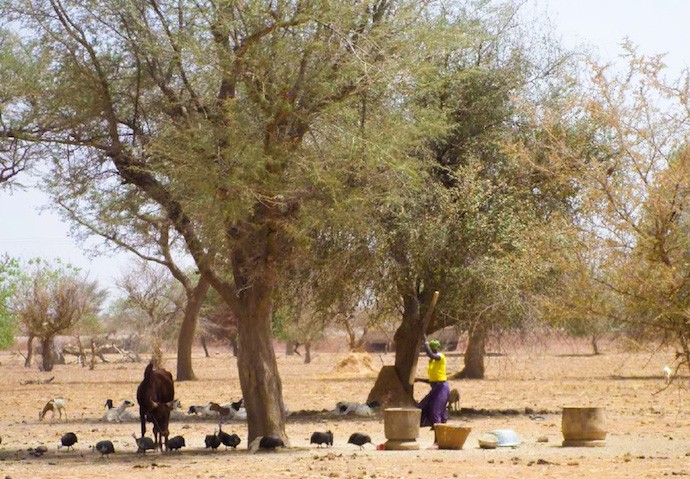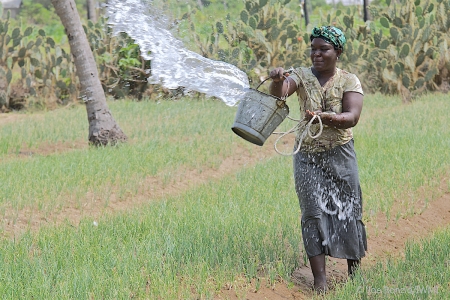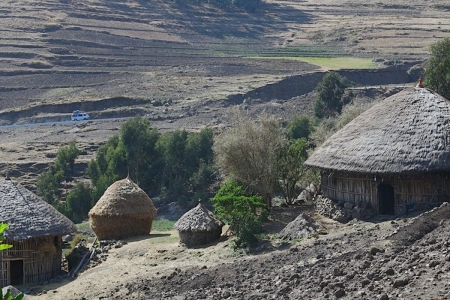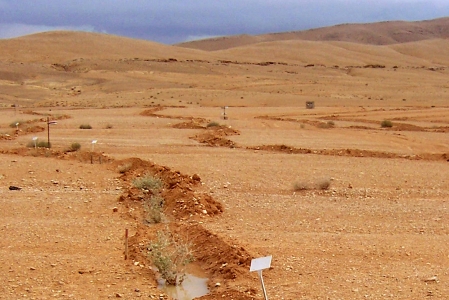Agricultural intensification is commonly identified as one way to address growing food security concerns and improve the income of smallholder farmers. However on a recent trip I took to Northern Ghana, I noticed that agricultural intensification could lead to adverse effects, affecting men and women in ways we perhaps haven’t yet considered.
 A cluster of trees found in the semi-arid regions of Northern Burkina Faso. Photo: Elsie Odonkor/IWMI
A cluster of trees found in the semi-arid regions of Northern Burkina Faso. Photo: Elsie Odonkor/IWMIIn March, I visited communities in the Nabdam and Bawku West districts in the Upper East Region of Ghana. Indigenous knowledge from community members linked the growth of certain clusters of tree species such as the shea (Vitellaria paradoxa) and dawadawa (Parkia biglobosa) to the presence of high water tables.
I then wondered: could the extensive use of groundwater for farming possibly lead to the extinction of larger trees like the shea and dawadawa?
Harvesting useful products from shea and dawadawa trees is a major source of income for women living in Northern Ghana. Shea nuts can be processed into butter for body cream and oil for cooking. Dawadawa beans are primarily processed into spices for cooking. Both trees are mainly found in the savannah belt.
In recent times, there has been a high incidence of forest and vegetation degradation leading to the extinction of certain tree species in specific areas of Northern Ghana. The causes, although not clearly established could be linked to human activities such as bush burning, charcoal production, firewood gathering and agricultural intensification.
Could this also be linked to biophysical factors such as soil types and lowered groundwater tables?
So what’s the connection?
In the arid areas of the Volta Basin, there are some locations with high water tables. Improving access to groundwater for farming is one of the interventions implemented in these areas. With access to groundwater, farmers can irrigate dry season crops increasing their income and/or improving their food security. It has been observed that areas earmarked with having high water table are areas where shea and dawadawa trees have thrived.
While on this recent site visit, which was part of a CGIAR Research Program on Water, Land and Ecosystems (WLE) project in the Volta and Niger region on landscapes and livelihood, I noticed shea and dawadawa trees near shallow hand dug wells in certain communities in the Nabdam district; I wondered if over extraction of this groundwater would affect the growth of these trees species, which women depend on for their income.
Although there are obvious benefits to improving irrigation through groundwater extraction, such as year-round cultivation and harvesting, research in India has showed that excessive use of groundwater has led to desertification in some areas.
Thus, could excessive exploitation of groundwater for farming have negative repercussions on the existence of trees such as the shea and dawadawa in the Northern regions of Ghana? Is there a link between groundwater levels and the existence of these trees? What are the major causes for the extinction of the trees? What are the long term implications for women?
Knowing that there are different gendered uses, i.e. roles of men and women, for natural resources and in particular water, there is the need to ensure that the extraction of groundwater is done to benefit all.
Let us know:
Have you noticed a connection between groundwater tables and shea or dawadawa trees? Is something to consider when promoting the use of groundwater for agriculture?
Please share your experiences with us in the comments section below.















